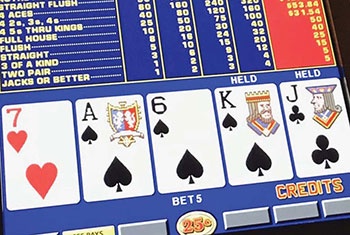ASKED & ANSWERED
Video poker players seek answers
By John Grochowski
 Video poker players love to raise questions about their games, and the questions aren’t limited to strategy puzzlers.
Video poker players love to raise questions about their games, and the questions aren’t limited to strategy puzzlers.
Often, questions from readers focus on how the games and odds work and why.
Why don’t royal flushes pay more when they’re so rare? How are best strategies calculated? Is a royal rarer than any other five-card hand?
Let’s tackle the questions as they arrived from video poker-playing readers.
PHIL: Royal flushes come up about once in 40,000 hands or so in video poker, but the payoff is only 800-for-1, and you only get that with a maximum bet. If you bet less, it’s only 250-for-1.
Shouldn’t the payoffs be a lot higher?
Maybe payoffs don’t have to be 40,000-1, but it seems like they should be in the tens of thousands. I’ll bet a lot more people would play with a jackpot like that.
ANSWER: If you called the game Royal Mania and paid off ONLY on royal flushes then yes, the pay- off would have to be a lot higher.
But that’s not how video poker works. You’re paid on a wide variety of hands, usually starting at a pair of Jacks.
A game such as 9-6 Jacks or Better returns 99.5 percent with expert play, but only about 2 percent of that return comes from royal flushes. The vast majority of your return comes from high pairs, two pairs, three of a kind, straights, flushes, full houses, four of a kind and straight flushes.
To pay more on royals while retaining a house edge would require adjusting the rest of the pay table. A combination of turning winning hands into losers and reducing returns on other hands would dramatically change the game.
Concentrating too much of the return into rare hands would turn video poker into an all-or-nothing game in which your rare big wins would be offset by no-win, big-loss sessions.
JODY: I’ve been thinking about a Joker’s Wild Kings or Better strategy where the chart says to hold Queen-10 of diamonds instead of discarding everything when the other cards are 2 and 4 of spades and 5 of clubs.
A long shot at a natural royal is part of the reason, I’m sure. Does the chance at a wild royal also figure into it? How is the strategy determined?
ANSWER: All possible outcomes are considered.
Per five coins wagered, the specific Joker’s Wild version Jody asked about pays 4,000 for a natural royal flush, 1,000 for five of a kind, 500 for a royal flush with Joker, 250 for a straight flush, 85 for four of a kind, 35 for a full house, 25 for a flush, 15 for a straight, 10 for three of a kind and 5 for two pairs or a pair of Aces or Kings.
If you hold Queen-10 of diamonds, there are 17,296 possible draws in a 53-card deck that includes a Joker. Of those, 14,807 are losing draws that bring no payback.
Among the paying hands, there are 645 high pairs, 711 two pairs, 584 with three of a kind, 294 straights, 210 flushes, 27 full houses, eight with four of a kind, six straight flushes, three wild royals and one natural royal.
The paybacks on all those possible winners are added, then di- vided by the number of draws, to get an average return of 1.79 coins per five coins wagered.
If you discard all five cards, there are 1,712,304 possible draws, including 1,344,068 losers. Among possible winning hands, there are 187,431 high pairs, 71,802 two pairs, 85,400 with three of a kind, 12,840 straights, 4,733 flushes, 3,942 full houses, 1,940 with four of a kind, 122 straight flushes, 15 wild royals, eight with five of a kind and three natural royals.
When the payoffs on all those winners are added and divided by the number of draws, the average return is only 1.65 coins.
That’s the way strategy evaluations work for every hand in every video poker game. All possible draws and payoffs are considered, and the average return per hand indicates our best strategy.
LES: I’ve been practicing video poker on my laptop, and I looked at some statistics. They say that there are 2,598,960 possible hands. Only four are royal flushes, so 1 in 649,740.
I get that royals come up a lot more often because of the draw, 1 in 40,000 or so. What I’m wondering is if the 2,598,960 are unique hands. It sure seems like I get something like 3 of clubs, 4 of diamonds, 7 of clubs, 9 of spades and 10 of hearts a lot more than a royal flush.
If you designated something like that as the big hand, would it be as rare as a royal?
ANSWER: Each hand in that 2,598,960 total is unique. Only one of those hands is 3 of clubs, 4 of diamonds, 7 of clubs, 9 of spades and 10 of hearts.
I’d point out that card order doesn’t matter in poker hands. If the order is 9 of spades, 10 of hearts, 3 of clubs, 7 of clubs and 4 of diamonds, it’s still the same hand as the one you listed and is counted in the total only once.
There are a lot more no-pay hands than winners. More than half the total—1,302,540 hands—have no pair or better. That’s not even differentiating between high and low pairs. A pair of 2s is a better start than more than half of the initial deals.
Would the hand you designated be as rare as a royal? It would be as rare as a royal in any given suit. With 3 of clubs, 4 of diamonds, 7 of clubs, 9 of spades and 10 of hearts, you have a hand as rare as Ace-King- Queen-Jack-10 of spades. It just doesn’t pay as well.


